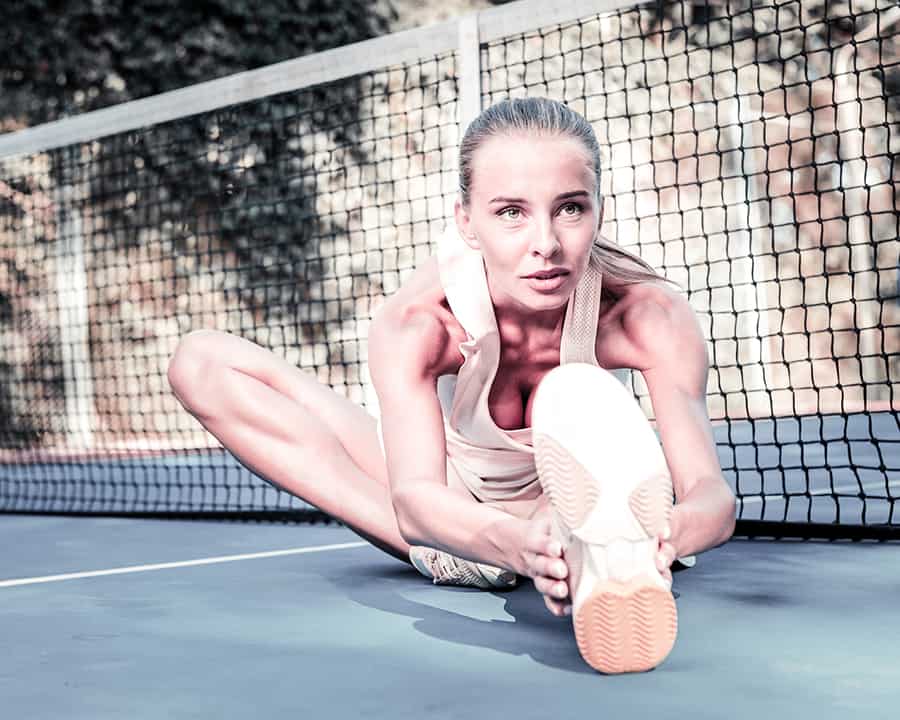If you are a pickleball enthusiast, you know that every Monday night on the court is a slice of heaven! There’s an exhilaration in the wack of the ball, the shuffle of quick feet, and the camaraderie/high fives of fellow players. But the love for pickleball comes with its share of concerns, particularly when it comes to preserving your knee health. In this comprehensive blog, we’ll dive deep into the art of maintaining healthy knees, supported by specific details, directions and expert advice to keep you at the top of your game. If you prefer a video over reading then click here to our YouTube channel where we describe exactly what you need to do to Protect YOUR Knees and STAY IN THE GAME.
Pickleball is about Lateral Movement and Pumping the Brakes
Picture this: you’re on the court, pickleball paddle in hand, your movements swift and strategic. The game is all about agility, getting to the kitchen quickly then lateral movement. Shifting from side to side, pivoting on your hips, and pushing off are not just tactical choices, but an integral part of being competitive in the game.
To excel in pickleball, you must maintain your glute health. But what exactly do your glutes have to do with the health of your knees? Well, it all comes down to strength, mobility, and stability – those are all buzzwords but what they really mean is the movement is generated through knee health, whether stopping or starting which ensures you stay agile on the court.
Knee Pain: More Than Meets the Eye
Before we dive into the details of maintaining knee health, it’s essential to understand that the knee isn’t a lone ranger. It’s part of a complex system that involves the femur, tibia, and ankle. These components are interconnected, and the well-being of your knee depends on how harmoniously they work together.
To safeguard your knees and keep them in prime condition, consider the following critical aspects:
- Ankle Mobility: The ability to bend your ankle is vital to your knee’s health. Without proper dorsiflexion(bending of the foot toward your lower leg), the movement through your gait cycle is disrupted, causing undue pressure on your knees. To improve your ankle mobility, incorporate calf stretches into your routine.
- Hip Mobility: The hips are your body’s powerhouse, allowing you to distribute stress away from your knees and giving you a balanced approach to movement. Ensuring they have good mobility, especially in external and internal rotation, can be a game-changer for your knee health.
- Hip Stability: Balance and stability on one leg are crucial for pickleball players. Exercises that involve pushing your knee out to the side can help build this stability, preparing you for those quick lateral movements on the court.
- Core Stability: Strengthening your core muscles is essential to protect your back and knees. Core exercises that resist motion coming from the sides, such as palloff presses and planks, can provide that much-needed stability.
- Hip Strength: The glute muscles play a pivotal role in preserving knee health. If they are weak, it can lead to poor knee alignment and function. Exercises like the standing fire hydrant can help activate and strengthen your glutes.
- Hip Hinge: A hip hinge is a fundamental movement pattern that should be at the core of your pickleball preparation. It helps you move through your hips, ensuring that your knees don’t take unnecessary stress.
- Hip Extension: Hip extension stretches are excellent for loosening up tight hip flexors, which are often the culprits behind knee issues for multiple reasons. By enhancing hip extension and maintaining activation to use it, you relieve tension on your knees and improve overall mobility.
- Glute Rollout: Loosening up your glutes can be incredibly beneficial for knee health. A simple tool like a lacrosse ball against a wall or door can help alleviate tension in your gluteal muscles, allowing for a smoother range of motion.
The Holy Grail of Knee and Back Health: The Hip
While the knee is often the center of attention, the hip plays a crucial role in maintaining knee and back health. Picture your body as a perfectly balanced scale, with the hips at the fulcrum, right in the middle. If your hips are robust and engaged, they act as a counterbalance, preventing undue stress on your knees and back.
One of the most common issues pickleball players face is the tendency for the knee to drift inward during lateral movements. This phenomenon is often accompanied by internal hip rotation, which not only hampers performance but can lead to back and serious knee pain down the line.
By ensuring that your hips are strong and mobile, you can prevent these problems from cropping up. The knee, positioned at the intersection of the femur and tibia bones, is significantly influenced by the health of these surrounding joints which have way more range of motion. When your hips are in peak condition, your knee alignment and function benefit, offering protection against common pickleball injuries.
The Knee’s “Achilles Heel”: Overuse and Misalignment
Pickleball players often face the issue of how to perform optimally while protecting the knee. The key is in understanding the anatomy of the knee and how it works in relationship to the other joints, especially the hips and ankles.
To maintain the health of the meniscus and other important connective tissue and ligaments and protect it from overuse, you need to ensure that the surrounding joints are functioning correctly. A significant issue arises when players consistently put pressure on their knees, often leading to irritation and, in extreme cases, injury. This is where the importance of a balanced approach comes into play.
Your knee should ideally be positioned outside your second toe and behind your toes during most movements. This posture distributes stress between the hip and knee, preventing overloading and safeguarding against potential injuries. So, although it might be tempting to consistently push your knees past your toes, it’s wiser to build strength and pliability in your glutes to maintain loaded glutes in a hinge position when you play pickleball.
Prolonged postures like a bad knee position should be avoided as well and the same principles apply. We don’t want to sit with stress on the inside of the knee. If you have pain with sitting for long periods then refer to the blog linked above.
The Reciprocal Inhibition Game
In the realm of muscle activation, the principle of reciprocal inhibition is a key player. This concept emphasizes the activation between opposing muscle groups. Just as flexing your bicep causes your tricep to relax, firing up your glute muscles can have a similar effect on your hip flexors. This interplay is crucial to knee health and preventing knee pain.
If your hip flexors are extremely tight from sitting for long periods of time which most of us normally do, at the computer, eating, riding in the car etc…
When your glutes are firing correctly, they inhibit the tension in your hip flexors. As a result, the tightness in the hip flexors, the involvement level of the quad muscles and overactivity of the back extensors all function improve, reducing the risk of overuse injuries. This makes maintaining strong and functional glutes a top priority for any pickleball player.

Warming Up for the Win
If you are focused on prolonging your pickleball career, hopefully as a centennial(over 100) and keep those knees in tip-top shape, a solid warm-up routine is the first step to preventing knee pain and knee injuries. I personally hate warming up but from experience, I know and you know that it’s extremely important to increase blood flow and wake up dormant muscles. Before you set foot on the court, it’s crucial to prepare your body for the demands of the game. Here’s a suggested warm-up routine that targets all the key areas we’ve discussed:
- Glute Rollout: Start by using a lacrosse ball against a wall or door to loosen up your glutes. Find the tender spots and apply gentle pressure, gradually relieving any built-up tension. 1 min each glute.
- Hip Hinge: The hip hinge is an integral part of using the hips consistently during any and all exercise, it ensures your hips are always in action. Initiate this motion with the right technique, focusing on hip movement rather than knee action. Refer to the video here.
- Hip Extension Stretch: Stretch your hip flexors by bending your hips back and driving through your glutes. Squeezing your back glute during this exercise will help alleviate tension in your hip flexors, making your knees more resilient and avoid going into hyperextension with your low back, it’s unnecessary and often harmful to over extend in a stretch.
- Shifting Exercise: In order to stay injury free, it is essential to consistently warm up the muscles that you will be using during pickleball. Fire up your glutes before you hit the court by taking two steps out then driving through with your hips to stop your momentum and change directions. Many of the pickleball injuries that we see involve the knees, which reiterates the importance of using your glutes in order to protect the knee.
Conclusion
The main goal here is to keep you doing the things you love, for even longer. The worst thing that you could do for a pickleball injury is ignore it and keep playing through the pain. If you feel like you may have an injury, it is best to let it rest and seek professional assistance from a physical therapist. This will help you avoid injuring yourself further and get you back on the court faster.
Don’t forget to subscribe to our YouTube channel for more informative content on managing and preventing injuries while playing the sports you love.
Committed to Your HEALTH and Recovery,
Jonathan
Dr. Jonathan Ruzicka PT, DPT, FAAOMPT
RPM Physical Therapy, The Woodlands Tx.
Dr. Jonathan Ruzicka is a Manual Therapist whose experience as a private therapist for professional athletes drove him to further his education attaining unparalleled skills in tissue mobility work, performance based rehab, injury prevention, myofacial release and joint mobilization to optimize human performance.
- 5 Lower Back Pain Stretches to Ease Your Discomfort - August 23, 2024
- How to Avoid Foot and Ankle Pain and Stay Active! - July 26, 2024
- Essential Stretches for Sciatica Pain: Your Path to Relief - June 10, 2024


